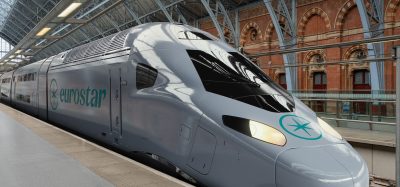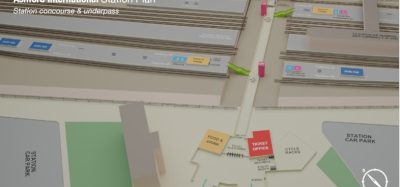Crossrail work gets underway
Posted: 12 December 2009 | | 1 comment
One of the biggest public transport projects in the world has started in London. Crossrail will provide welcome work at a time when other parts of the construction sector are experiencing a downturn. London is the poor relation amongst European cities when it comes to cross-city suburban rail links. While Paris has its Regional Express (RER) system and German cities their S-Bahns, the British capital struggles on with 19th century suburban rail termini that ring the core of the city. Only one line crosses from one side of the city to the other.
One of the biggest public transport projects in the world has started in London. Crossrail will provide welcome work at a time when other parts of the construction sector are experiencing a downturn. London is the poor relation amongst European cities when it comes to cross-city suburban rail links. While Paris has its Regional Express (RER) system and German cities their S-Bahns, the British capital struggles on with 19th century suburban rail termini that ring the core of the city. Only one line crosses from one side of the city to the other.
One of the biggest public transport projects in the world has started in London. Crossrail will provide welcome work at a time when other parts of the construction sector are experiencing a downturn.
London is the poor relation amongst European cities when it comes to cross-city suburban rail links. While Paris has its Regional Express (RER) system and German cities their S-Bahns, the British capital struggles on with 19th century suburban rail termini that ring the core of the city. Only one line crosses from one side of the city to the other.
In the next decade, all that is set to change. A cross-shaped system is being constructed in London that will rival those of Continental cities. London’s sole present cross-city route, the north-south Thameslink line, is being upgraded so that by 2015 it will be able to accommodate 24 trains, each 12 cars long, in each direction per hour. The upgraded Thameslink route will intersect with a new east-west line, Crossrail, at Farringdon in the City of London.
Crossrail will run 118km from Maidenhead and Heathrow in the west, through new twin-bore 21km tunnels under central London to Shenfield and Abbey Wood in the east. It will bring an additional 1.5 million people within 60 minutes’ commuting distance of London’s key business districts. When Crossrail opens it will increase London’s public transport network capacity by 10%, supporting regeneration across the capital, helping to secure London’s position as a world leading financial centre, and cutting journey times across the city.
Preparatory works are well advanced and the main Crossrail construction is due to start in 2010. The line is scheduled to open for service in 2017.
Project delivery
The Crossrail Act received Royal Assent on 22 July 2008, granting the powers to build the railway. On 24 July 2008, Crossrail Ltd (CRL) was appointed the lead Nominated Undertaker for the delivery of the railway.
CRL is a public sector body, owned by the Greater London Authority/Transport for London, with the Secretary of State at the Department for Transport having influence through a joint steering team overseeing CRL.
The private sector will execute the construction of the railway. Two key partners in the project have been appointed: the Programme Partner and the Project Delivery Partner.
The Programme Partner is a joint venture, Transcend, which has a strong North American element. The Programme Partner will help Crossrail Ltd on issues such as scoping the work – in effect, Transcend will be considered a part of CRL.
Transcend comprises Aecom, the US consultancy whose British arm was until recently known as Faber Maunsell, but is now branded Aecom; CH2M Hill, again from the US; and Nichols of the UK.
Speaking to Global Railway Review, Peter Koning, Director – Transportation with Aecom in the UK, said: “While we will be bringing in US expertise, 90% of those staffing it (Transcend) will be UK-born.”
The joint venture will be able to draw on the skills of its partner companies – for example, Aecom’s strength in environmental issues and CH2M Hill’s in costing concerns – and apply those through locally-sourced staff.
Underneath Crossrail Ltd and the Programme Partner in the organisation diagram is the Project Delivery Partner. The giant American engineering consultancy Bechtel has been appointed to perform this role. Bechtel is already well known in the UK railway sector from its work on the Jubilee Line Extension, High Speed 1 (HS1) and the West Coast Route Modernisation. Bechtel will be responsible for ensuring the tunnel gets dug, on time and to budget.
Rob Holden, who as Executive Chairman of London & Continental Railways brought Britain’s first high-speed line into use on time and on budget in 2007, is now Chief Executive of Crossrail Ltd. He worked with Bechtel on HS1 and said at a recent conference in London that the American firm has “a real ‘can-do’ attitude.” He added: “They are a phenomenal organisation, and if we select the right individuals for our organisation and work with the people from Transcend I am confident we will have a project to be proud of in 2017.”
Some talented people have already been attracted to work on Crossrail. They include Andy Mitchell, who until recently was Major Programme Director on Network Rail’s Thameslink Programme; he is now Programme Director for Crossrail.
Dave Bennett has been appointed Crossrail Implementation Director: he will work closely with Bechtel to ensure the major construction element of the Crossrail programme is delivered on time and to budget. Rob Holden worked with Dave Bennett on HS1 – Dave Bennett was Implementation Director on that project.
Since 1 June 2009, Terry Morgan has been Chairman of Crossrail: he established his leadership credentials at the helm of Tube Lines, the privately-owned company involved in London Underground modernisation.
Industry partners
Crossrail Ltd will have a number of other partners on the project. BAA, the operator of London’s principal airport at Heathrow, is providing a financial contribution to the Crossrail project and Crossrail trains will use the BAA-owned railway tunnel under the airport.
London Underground Ltd, the operator of the metro system in the British capital, will assist with various aspects of the project. Importantly, some key interchanges, such as Tottenham Court Road and Bond Street in the centre of London, will be joint London Underground/Crossrail stations.
Network Rail, the owner of Britain’s main line railway infrastructure, has a key role to play as Crossrail will use Network Rail tracks on the east and west sides of London. Changes will have to be made to this infrastructure to accommodate Crossrail: for example, the Great Western line from Airport Junction to Maidenhead, currently diesel-operated, will have to be electrified on the 25kV AC system for Crossrail trains. Network Rail is spending £2.3 billion on Crossrail work, and has appointed Bechtel to assist in the task of making Network Rail infrastructure Crossrail-ready. Design has been awarded to Scott Wilson, which has a contract worth more than £9 million that covers the lion’s share of Network Rail’s Crossrail design workload. Halcrow is also undertaking some design work on the project.
Two companies in the property sector are involved in building two new stations on the east side of London. Canary Wharf Group (CWG), owner of the office complex that accommodates many financial institutions in London’s Docklands, will deliver the new station there. The group is contributing £150 million to the Crossrail project. CWG has selected Laing O’Rourke for enabling and civil engineering works at the Isle of Dogs Crossrail station at Canary Wharf. Above the Isle of Dogs station will be approximately 100,000 square feet of retail space designed by Foster + Partners and a roof-top park and community facility designed by Gillespies, with views out over the Docks and Canary Wharf beyond.
Berkeley Homes will deliver the box for the new station at Woolwich, which will serve an area that is currently run-down but which will be regenerated with new housing estates.
Crossrail Ltd will also have a client relationship with utility companies providing services such as electricity.
Design work
Underneath the partner tier of the organisation diagram are the contractors. Crossrail Ltd has set up a series of contractual relationships that will allow it to call off work as the project progresses, pre-appointing companies with framework agreements and then allocating specific tasks to them as and when required. In December 2008, Crossrail announced 12 firms had secured Design Framework Agreements. The chosen firms have the opportunity to compete for packages of design work on the Crossrail project, including work on tunnels and shafts, stations, and railway systems.
The 12 firms are: Aedas Group Ltd, Atkins Ltd, BDP Ltd, Capita Symonds Ltd, Halcrow Group Ltd, Hyder Consulting (UK) Ltd, Jacobs Engineering UK Ltd, Mott MacDonald Ltd, Ove Arup & Partners International Ltd, Parsons Brinckerhoff Ltd, Scott Wilson Railways Ltd, and WSP UK Ltd.
By the middle of 2009, Crossrail was ready to start handing out design work under this arrangement. By October 2009, most of the design work had been awarded, with the following packages handed out:
- Package C150 – Royal Oak Portal – Capita Symonds Ltd
- Package C121 – Sprayed Concrete Lining – Mott MacDonald
- Package C122 – Bored Tunnels – Ove Arup & Partners International Ltd
- Package C134 – Tottenham Court Road Station – Ove Arup & Partners International Ltd
- Package C100 – Architectural Component Design – Atkins
- Package C152 – Pudding Mill Lane Portal – Scott Wilson
- Package C124 – Tunnels and Shafts Aerodynamics and Ventilation – Mott MacDonald
- Package C136 – Farringdon Station Design – Scott Wilson
- Package C123 – Intermediate Shafts – Jacobs
- Package C164 – Bulk Power Distribution & HV Power – Scott Wilson
- Package C175 – Tunnelling Academy Design – Capita Symonds
- Package C125 – M&E in Tunnels – Mott MacDonald
- Package C162 – Signalling, traction power OHLE and platform screen doors – Mott MacDonald
- Package C154 – Victoria Dock Portal – Hyder
- Package C156 – North Woolwich and Plumstead Portals – Capita Symonds
- Package C132 – Bond Street Station – WSP
- Package C130 – Paddington Station – Scott Wilson
- Package C131 – Paddington Integration Project – Mott MacDonald
- Package C138 – Liverpool Street Station – Mott MacDonald
- Package C140 – Whitechapel Station – Hyder
Crossrail has also appointed the majority of its station design contracts for the central area stations. The list of design contractors and their appointed architects is shown in Table 1.
The final station design contract for the Custom House station is likely to be let before the end of 2009. The stations at Canary Wharf and Woolwich are being delivered by Canary Wharf Group and Berkeley Homes Group respectively.
Contractors
With allocation of the design packages proceeding, Crossrail is now portioning up the site work.
On 9 April 2009, Enabling Works Framework Agreements were awarded to 17 companies. The chosen firms will have the opportunity to compete for packages of enabling works for the Crossrail project, including site facilities, demolition, civil structures and utilities on the central section of Crossrail route. Each framework agreement will run for four years.
The successful bidders are:
- Site facilities: Select Plant Hire Company, BAM Nuttall and Fitzpatrick Contractors.
- Demolition: Laing O’Rourke Construction, John F. Hunt Demolition, McGee Group, Keltbray, Brown & Mason, P. J. Carey (Contractors) Ltd, BAM Nuttall Ltd and Kier Construction Ltd.
- Civils: Laing O’Rourke Construction, Costain Skanska JV, Carillion Construction, Civils Engineering, Kier Construction, Morgan Est, J. Murphy and Balfour Beatty Civil Engineering.
- Utilities: Morgan Est, Costain Skanska Construction JV, McNicholas Construction, J. Murphy, Clancy Docwra and Laing O’Rourke Construction.
Tunnelling
In August 2009, Crossrail published notices in the Official Journal of the European Union (OJEU) inviting expressions of interest for two principal tunnelling contracts – Package C300 for Tunnels West and Package C305 for Tunnels East.
The publication of these OJEU notices marked the beginning of the procurement process for the construction of the new Crossrail tunnels in central London. Tenders were scheduled to be invited around November with contracts awarded by mid-2010.
A total of 21km of twin-bore tunnel are required to be constructed for Crossrail. The two OJEU contracts that have been published are for a total of 18km of twin-bore tunnel.
The two tunnelling contracts are:
- Package C300 – Tunnels West comprises the construction of twin 6.2m diameter bored tunnels from west of Paddington station through to the new Crossrail Farringdon station
- Package C305 – Tunnels East comprises the construction of twin 6.2m diameter bored tunnels from:
- A launch chamber at Limmo peninsula through to the new Crossrail Farringdon station, length of drive approximately 8.3km
- A launch chamber at Stepney Green through to Pudding Mill Lane portal, length of drive approximately 2.7km
- A launch chamber at Limmo peninsula through to Victoria Dock portal, length of drive approximately 0.9km
Upon award, the successful contractors will commence design and construction of a tunnel segment manufacturing facility at a site to be designated by CRL, so that there will be a sufficient supply of tunnel segments available upon commencement of tunnelling.
The C300 contract involves supply of two Earth Pressure Balancing Machine (EPBM) tunnel boring machines (TBMs) for the twin drives from Royal Oak portal to Farringdon station (Drive X). The contract award has been scheduled so that the successful contractor has sufficient time to complete design, manufacture, delivery and erection of the TBMs in advance of tunnelling and to provide construction planning, temporary construction design and constructability input into the final detailed design prior to mobilisation to site. The C305 contract involves supply of four EPBM TBMs; two for the twin drives from Limmo shaft to Farringdon station (Drive Y) and two for the twin drives from Stepney Green shaft to Pudding Mill Lane (Drive Z) and then from Limmo shaft to Victoria Dock portal (Drive G). The contract award has been scheduled so that the successful contractor has sufficient time to complete design, manufacture, delivery and erection of the first two TBMs in advance of commencement of tunnelling from Limmo shaft and to provide construction planning, temporary construction design and constructability input into the final detailed design prior to mobilisation to site. The main Crossrail construction programme begins in 2010, with main tunnelling commencing in 2011. Tunnelling drives are as follows:
- Drive X – Royal Oak portal to west of Farringdon station
- Drive Y – Limmo peninsula to east of Farringdon station
- Drive H – Plumstead portal to North Woolwich
- Drive Z – Pudding Mill Lane portal to Stepney Green shaft
- Drive G – Limmo peninsula shaft to Victoria Dock portal.
Paddington Integrated Project
In mid October 2009, Crossrail invited bids for the construction component of the Paddington Integrated Project, the works required to allow Paddington to accommodate a new Crossrail station.
Contract C272 covers a range of Crossrail enabling works including construction of a shell for the relocated Hammersmith & City Line tube station, alterations to platform 12 to improve passenger circulation and structural works to allow future over-site development.
The taxi rank will be relocated and the space thus vacated will eventually form a piazza with entrances to the Crossrail ticket hall being built underground. Initially, the space will give contractors access to build the new ticket hall and Crossrail platforms, on which work is scheduled to start in spring 2011.
Contract C272 is one of the first station construction jobs to be let because work needs to be completed before the main Paddington Crossrail contract can get underway. As noted above, Mott MacDonald is design consultant for the Paddington Integrated Project under C131, working with architect Weston Williamson which is also signed up to the main Paddington design job (C130) with Scott Wilson. Geotechnical specialist London Bridge Associates is involved with both contracts.
Tenders for the C272 work were due in November, with construction works for the Paddington Integrated Project expected to start by the end of 2009.
Other work
With allocation of the civil work well in hand, Crossrail is turning its attention to rolling stock. The stations will be built with the ability to handle 2×6-car trains, but initially the fleet will comprise 5-car units assembled as 10-car trains. Rolling stock procurement is expected to start as early as next year, with a view to commissioning the first trains in late 2015 and having the whole fleet operative by early 2018.
On this timetable, the first trains will be ready a couple of years before the central London tunnel is complete, allowing plenty of time for bedding down and sorting out teething troubles. Rob Holden said: “We hope to avoid commissioning new rolling stock and infrastructure at the same time – that is a lesson we have learned from HS1,” where tried-and-tested Eurostar trains were introduced onto the new infrastructure.
One contract outside the scope of the main contract structure concerns the logistical aspects of Crossrail. DHL Exel Supply Chain has been appointed to undertake a logistics study with the aim of minimising the impact of Crossrail’s construction on central London. The study will determine the most efficient way for materials and equipment to be delivered to key central London construction sites, while also ensuring smooth traffic flows.
Preliminary plans are that most of the spoil coming out of the tunnel at the western end will be taken away by rail to landfill sites in Kent, while spoil coming out at the east will go by water to an island off the Essex coast. Crossrail plans to enhance this island as a bird nesting and migration site, and is working on this project in conjunction with the Royal Society for the Protection of Birds.
Overseeing the project
Construction work is now getting underway on the project. On 15 May 2009, in a ceremony at Canary Wharf, Gordon Brown, the British Prime Minister, marked the start of work there.
The Department for Transport has appointed Jacobs Engineering UK Ltd as the Project Representative for Crossrail. The Project Representative will provide oversight support to the project sponsors (DfT and Transport for London) to ensure that Crossrail Ltd delivers the project on schedule, within budget and to the agreed standard.
The industry partners involved in Crossrail will be keen to ensure that the Government has no reason to find fault in the project. At a time of tight public finances, keeping the cash tap open for the £15.9 billion Crossrail project will be a delicate political task. Rob Holden said that if Crossrail was cancelled before the end of 2009, the taxpayer will be faced with unavoidable costs amounting to approximately £1billion. Wait another year, and it would be £2 billion.
The industry will be watching with baited breath in the hope that Crossrail does not become a victim of old-style stop-go public financing, but is pursued through to completion to fulfill a key role in London’s public transport network.


Table 1
Global Railway Review Autumn/ Winter Issue 2025
Welcome to 2025’s Autumn/ Winter issue of Global Railway Review!
The dynamism of our sector has never been more apparent, driven by technological leaps, evolving societal demands, and an urgent global imperative for sustainable solutions.
>>> Read the issue in full now! <<<







